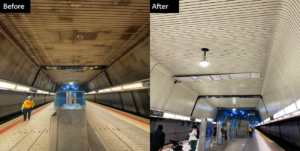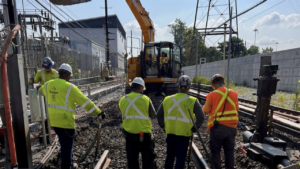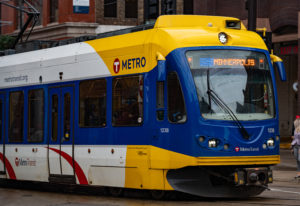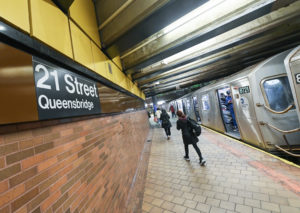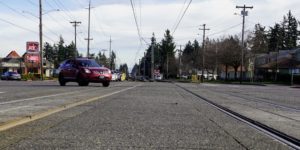Undercutting Leaves Roadbed in Excellent Shape
Written by David Clarke, Ph.D., P.E. Center for Transportation Research (retired) The University of Tennessee, Knoxville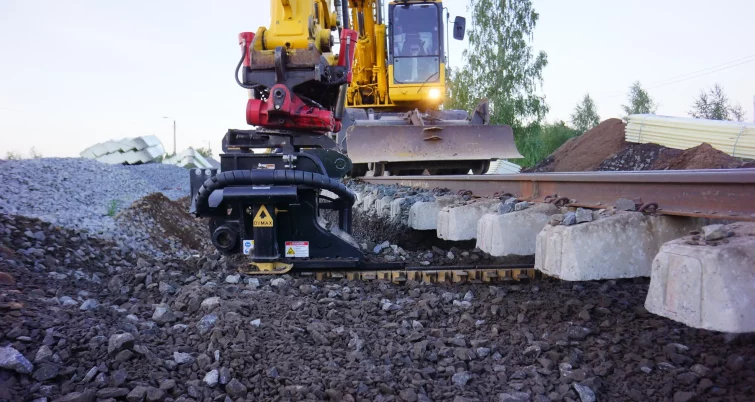
Undercutting is a process that removes ballast from beneath an in-situ railroad track. Undercutters can typically extract between six and twenty-four inches of material in a pass.
Typically, undercutting is performed to remove poor quality, fouled, or degraded ballast so that the material can be replaced with fresh, good quality material. This restores drainage and strengthens the track substructure.
Another reason to undercut is to lower a track. Over time, addition of ballast during routine surfacing operations raises a track’s elevation. This can lead to “humped” rail-highway crossings and reduced clearances in tunnels and below overhead obstacles. The track elevation is lowered by removing excess ballast.
Undercutting can also remove ballast that has become contaminated from a spill. Thus, it has a role in environmental remediation.
The classic undercutting approach employs a moving chain to carry away the ballast beneath the crossties. Large rail-bound undercutting machines use a chain loop that encircles the track. The chain is initially inserted in a prepared slot between two crossties and the ends connected. As the machine moves forward, the rotating chain loop cuts away the ballast and moves it to the shoulder. Instead of a chain cutter, some machines employ rotating cutting wheels inserted from each side of the track. These take less time to set up than the chain, potentially increasing productivity. Either type of machine may also have the capability to remove shoulder ballast.
One type of off-track undercutter consists of a crawler equipped with a boom mounted chain-bar assembly. The bar is long enough to extend completely under the track. The chain bar is inserted in the ballast below the crossties and power applied. The moving chain carries the ballast out from under the track. Insertion of the chain bar is facilitated by removal of the shoulder ballast, which must be performed separately.
While some do not consider use of a plow or blade for ballast removal to be undercutting in the purest sense (technically, they scrape rather than cut), these methods can accomplish the same results. The track plow is a device inserted in the ballast layer below the crossties. It may be part of a larger machine or pulled by other means. As the plow moves forward, it lifts the track and pushes a layer of the old ballast underneath towards the shoulders. The skeletonized track left behind is ready for the application of fresh ballast.
Bulldozers can be equipped with a blade extension designed to extend into the ballast underlying the crossties. As the machine moves alongside the track, the extension pushes the ballast out in similar fashion to the track plow.
Off-track undercutters need convenient access and adequate working space alongside the track. On-track machines may be better suited to work in cuts, fills, and tunnels. On-track machines offer higher productivity rates, but have more impact on train traffic.
Large production undercutters can be capable of cleaning the removed ballast and returning usable material to the track bed. Additional ballast may still be needed, and the track will have to be brought to the desired grade and tamped.
Smaller railbound undercutters and most, if not all, of the off-track undercutters waste the removed ballast. In cuts and tunnels, this must be loaded and removed. New ballast will need to be brought in so that the track can be brought to grade and tamped.
Regardless of the method employed, undercutters should be accompanied by a tamper and regulator. The initial track surface left by undercutting may be suitable for low speed train operation, but tamping and regulating is generally needed to restore geometry to track class standards and stabilize the track.
Insertion and removal of the undercutting mechanism can be time consuming. This is necessary at the start and end of the day and to by-pass grade crossings, special trackwork (turnouts and track crossings), and bridges. Traditional undercutters are not suitable for special trackwork, but machines adapted for these locations are available.
During the undercutting process, care must be taken to avoid damage to buried cabling, wayside sensors, lubricators, and other infrastructure elements. Unknown objects in the track bed (old rails, crossties, timbers, etc.) can also damage the undercutter mechanism, especially the chain types.
During undercutting, ties must hang from the rails. Ties that are not effectively fastened will drop free onto the track bed. Renewing ties before undercutting, or making provision to do so while the track is skeletonized, is advisable.
While some production undercutting systems advertise a rate of 900-1000 ft/hour under ideal conditions, actual productivity varies greatly. Factors include the type of equipment used, track and ballast conditions, and number of by-pass operations required.
Planning for an undercutting operation requires careful consideration of cost, productivity, and operational impacts. Concerns about these factors, and perhaps the general reluctance of track engineers to disturb the track bed, have traditionally limited undercutting to isolated locations where no other solution appears viable. Nevertheless, the method has a long history of success in improving track performance and deserves serious consideration for addressing under track ballast conditions.

